Hummingbird migration map represents one of nature’s most extraordinary phenomena, featuring aerial journeys of epic proportions undertaken by the world’s smallest birds. Each year, these tiny aviators complete incredible long-distance migrations, with some species traveling thousands of miles between their breeding and wintering grounds. The Ruby-throated Hummingbird, for instance, undertakes a remarkable 500-mile non-stop flight across the Gulf of Mexico, a 20-22 hour marathon requiring significant fat reserves and extraordinary endurance.
Understanding hummingbird migration patterns isn’t just fascinating for bird enthusiasts—it’s crucial for conservation efforts and habitat protection. As climate patterns shift and natural landscapes transform, tracking these migration routes helps scientists identify critical stopover sites and implement targeted conservation strategies. This comprehensive guide examines the latest migration map, data, explores the science behind their incredible journeys, and provides practical advice for supporting these remarkable birds throughout their annual cycles.
Hummingbird Migration Map – Your Visual Guide to Movement Patterns
Hummingbird migration maps provide real-time visual representations of these birds’ annual movements, showcasing their gradual progression across continents. These tools combine scientific data collection with community observations to create accurate forecasts of when different species will arrive in specific regions.

The interactive migration maps available from organizations like the Cornell Lab of Ornithology utilize crowdsourced data from platforms like eBird, enabling researchers to track species movements with unprecedented precision. These resources are invaluable for both scientists and backyard birders seeking to anticipate arrivals in their specific regions.
Hummingbird Migration Timing Patterns
Migration timing varies significantly by species and region, though general patterns remain consistent annually. The following table outlines typical spring migration windows across different U.S. regions:
| Region | Early Migrants Arrive | Peak Migration | Ruby-throated Appearance |
|---|---|---|---|
| Southern States | Early March | Mid-March | Late March |
| Mid-Atlantic & Midwest | Mid-April | Late April | Early May |
| Northeast & Northern States | Late April | Early May | Mid-May |
| Pacific Northwest | Early April | Mid-April | Late April (varies by species) |
Table based on 2025 hummingbird migration tracking data
In autumn, the reverse migration typically begins as early as July for some adult males, with most species departing northern areas by October. The timing is influenced by complex environmental cues including daylight changes, flower blooming cycles, and insect population dynamics.
Hummingbird Migration Routes and Flyways
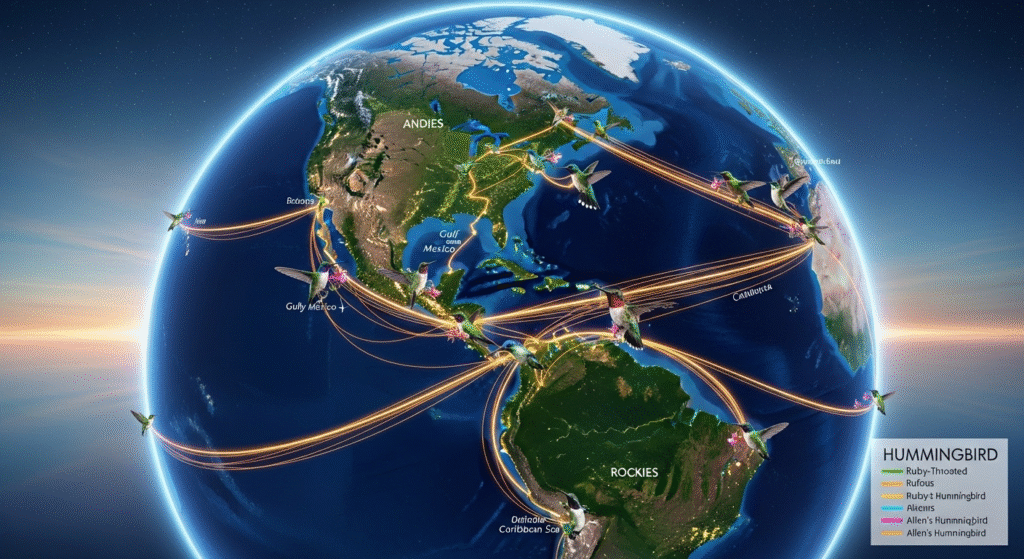
Hummingbirds follow established migratory corridors shaped by geography, food availability, and genetic memory. These aerial highways have been refined over millennia to maximize survival chances during these perilous journeys.
Major Migration Flyways
- Eastern North American Route: Used primarily by Ruby-throated Hummingbirds, this path moves northward from Central America through Mexico, then splits either across the Gulf of Mexico or along the Texas coast through the Mississippi River Valley into the Eastern United States and Canada.
- Western Mountain Corridors: Multiple species including Rufous, Allen’s, and Black-chinned Hummingbirds follow the Pacific Flyway, moving along coastal and inland mountain ranges from Mexico through California, Washington, and into British Columbia and Alaska.
- Central American Pathways: Dozens of species native to Central and South America undertake altitudinal migrations, moving between different elevations in response to seasonal flowering patterns rather than traveling latitudinal distances.
Species-Specific Migration Routes
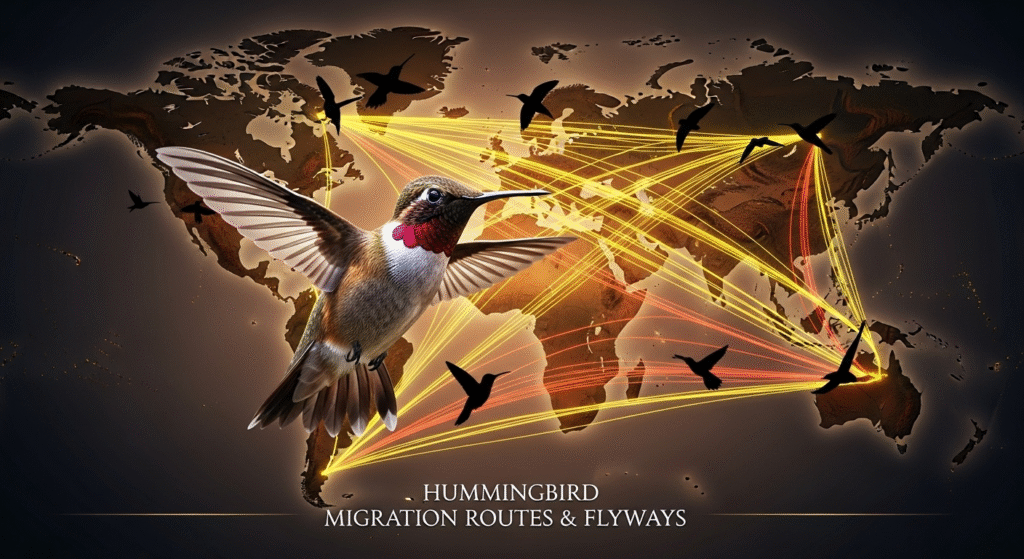
- Ruby-throated Hummingbirds: Approximately 75% of the population crosses the Gulf of Mexico directly each spring, a 500-mile non-stop journey requiring significant fat reserves. The return journey in fall typically follows a land-based route along the Texas coast.
- Rufous Hummingbirds: Hold the record for the longest migration relative to body size, traveling up to 3,900 miles from Mexico to Alaska—the equivalent of 78,470,000 body lengths. Their route forms a clockwise loop northward along the Pacific Coast in spring and southward through the Rocky Mountains in late summer.
- Allen’s Hummingbirds: Follow a coastal route from Mexico to the Pacific Northwest, with two distinct populations—one migratory and one resident year-round in Southern California.
The Science of Hummingbird Migration: Triggers, Navigation, and Amazing Physiological Adaptations
Hummingbird migration involves a complex interplay of environmental triggers, navigational capabilities, and extraordinary physiological adaptations that enable these tiny birds to undertake such monumental journeys.
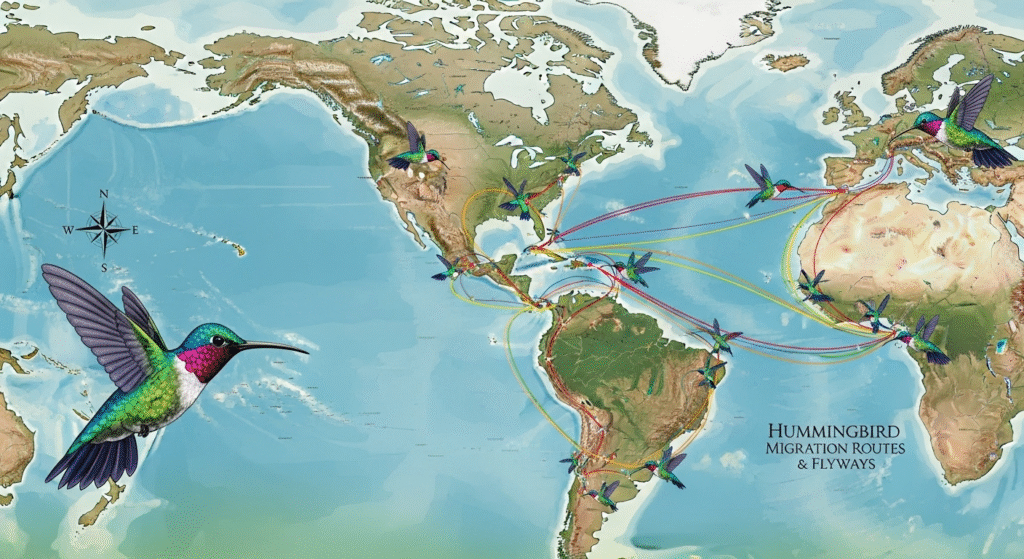
Migration Triggers and Timing
Hummingbirds don’t migrate in response to temperature changes alone. Their movement is primarily triggered by:
- Photoperiod changes: The changing day length triggers hormonal responses that prepare birds for migration
- Food availability: Natural flower blooming cycles and insect populations signal when to move
- Genetic programming: Innate biological clocks guide timing regardless of individual experience
- Fat accumulation: Sufficient energy reserves must be stored before departure
Incredible Physiological Adaptations
To accomplish their migratory feats, hummingbirds undergo remarkable physiological changes:
- Hyperphagia: Migrating hummingbirds enter a feeding frenzy, increasing their body weight by 25-40% with fat deposits
- Torpor utilization: They can enter a state of deep torpor during stopovers, reducing metabolic rate by up to 95% to conserve energy
- Muscle transformation: Flight muscles become more efficient at fat metabolism for endurance flying
- Organ shrinkage: Some non-essential organs temporarily reduce in size to save weight and energy
Navigational Mechanisms
How do hummingbirds navigate such precise routes over thousands of miles? Research suggests they use multiple sophisticated systems:
- Solar positioning: Tracking the sun’s position throughout the day
- Star patterns: Nocturnal migrants may use celestial navigation
- Geomagnetic sensing: Detecting Earth’s magnetic fields through specialized photoreceptors
- Visual landmarks: Recognizing geographical features along established routes
- Olfactory cues: Potentially using smell for orientation in some contexts
Threats and Conservation: Challenges Along Migratory Routes
Migrating hummingbirds face numerous threats throughout their journeys, many of which have intensified in recent years. Understanding these challenges is the first step toward effective conservation.
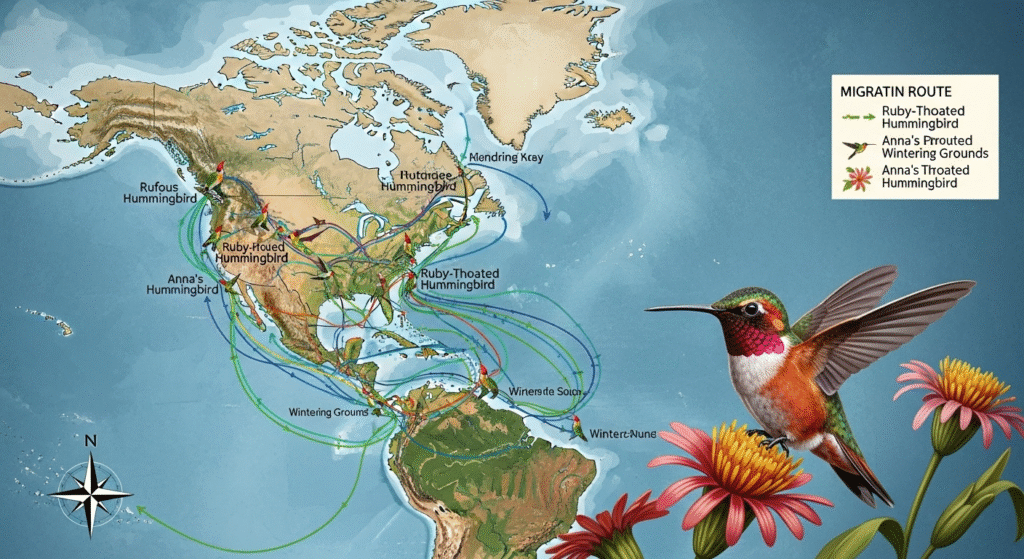
Major Threats to Migrating Hummingbirds
- Habitat loss: Critical stopover sites and feeding areas are rapidly disappearing due to urban development and agriculture
- Climate change: Shifting flowering and insect emergence times create mismatches with migration arrival
- Pesticide use: Reduces insect populations (vital protein sources) and can directly poison birds
- Window collisions: Millions of birds die annually from striking buildings, especially during migration
- Extreme weather: Storms and droughts can devastate populations during vulnerable migratory periods
- Light pollution: Artificial lights can disorient nocturnal migrants, leading to fatal collisions or energy depletion
Conservation Success Stories and Initiatives
Despite these challenges, targeted conservation efforts have yielded positive results:
- Hummingbird Gardens: The creation of interconnected nectar-rich habitats along migration routes provides crucial fueling stations
- Lights Out programs: Urban initiatives that encourage building owners to turn off unnecessary lights during migration peaks
- Citizen science: Projects like eBird and Journey North enable researchers to track populations and identify trouble spots
- International partnerships: Cross-border conservation agreements protect habitats across the entire migratory range
- Native plant initiatives: Education campaigns promoting the use of native flowering plants in urban and suburban landscapes
How to Help Migrating Hummingbirds?
You can play a vital role in supporting hummingbirds during their arduous migrations by providing critical resources along their journey. Here are evidence-based strategies for creating hummingbird-friendly habitats:
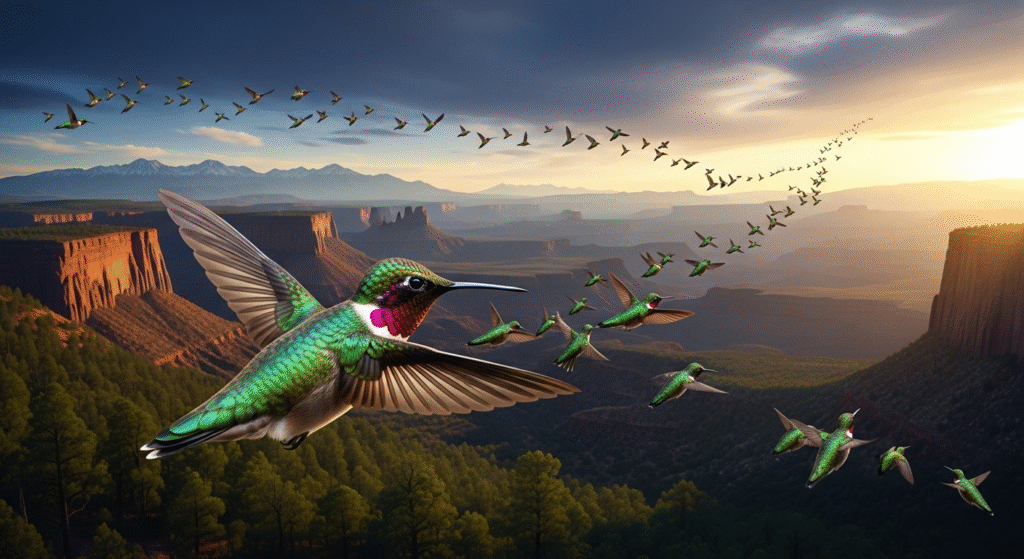
Strategic Feeding Stations
- Provide multiple feeders: Place several feeders in different locations to reduce territorial aggression
- Use proper nectar ratio: Mix 1 part white granulated sugar with 4 parts water—no food coloring needed
- Maintain cleanliness: Clean feeders every 2-3 days with hot water and vinegar to prevent fungal and bacterial growth
- Time placement correctly: Put feeders up approximately two weeks before expected arrival in your area
- Leave feeders up: Keep feeders available for at least two weeks after your last fall sighting to support stragglers
Creating Natural Habitat Corridors
- Plant native species: Choose tubular flowers in red, orange, and pink hues that co-evolved with hummingbirds
- Ensure bloom succession: Select plants that flower at different times providing nectar throughout migration seasons
- Include insect-friendly plants: Support healthy insect populations by including host plants and avoiding pesticides
- Provide water sources: Install misters or shallow drippers since hummingbirds prefer moving water for bathing
- Offer shelter: Include trees and shrubs for perching and protection from predators and weather
Regional Planting Recommendations
- Northeast: Bee balm, cardinal flower, trumpet honeysuckle
- Southeast: Coral honeysuckle, crossvine, scarlet sage
- Southwest: Desert honeysuckle, penstemon, chuparosa
- Pacific Northwest: Red flowering currant, California fuchsia, salmonberry
- Rocky Mountains: Indian paintbrush, scarlet gilia, Colorado columbine
Frequently Asked Questions About Hummingbird Migration
How far do hummingbirds migrate?
Migration distances vary by species. Ruby-throated Hummingbirds travel up to 2,000 miles between Central America and Canada, while Rufous Hummingbirds may journey nearly 4,000 miles from Mexico to Alaska—the longest migration relative to body size in the animal kingdom.
When do hummingbirds migrate?
Spring migration typically occurs February through May, with males arriving 1-2 weeks before females at breeding grounds. Fall migration runs July through October, with males departing first, followed by females and then juveniles.
How do hummingbirds find their way?
Hummingbirds navigate using multiple systems including the sun’s position, star patterns, Earth’s magnetic fields, and visual landmarks. Young birds make their first migration alone using innate genetic programming.
Do hummingbirds migrate in groups?
No, hummingbirds are solitary migrants. They don’t form flocks like many other bird species, though multiple individuals may congregate at abundant food sources along migration routes.
How long does migration take?
The complete migration may span several months as birds travel in stages, stopping for days or weeks at productive locations to refuel. The actual flight time for long crossings like the Gulf of Mexico is 18-22 hours non-stop.

Can I keep my feeders up too late?
No—this is a common misconception. Feeders won’t prevent migration, which is triggered by photoperiod changes. Keeping feeders up late may actually help stragglers and late migrants build crucial energy reserves.
Why do hummingbirds disappear from my feeders in late summer?
This often indicates local birds have begun migration, not that something is wrong with your feeders. Maintain nectar freshness as migrants may stop briefly but be less visible than resident birds.
How high do hummingbirds fly during migration?
Most migration occurs at tree-top level, but hummingbirds have been recorded flying up to 500 feet altitude, especially when crossing large bodies of water or mountain ranges.
Conclusion: Witnessing One of Nature’s Greatest Journeys
The annual hummingbird migration represents one of nature’s most remarkable phenomena – a testament to endurance, navigation, and survival against incredible odds. By understanding their routes, timing, and needs throughout this arduous journey, we can better support these extraordinary birds and ensure their migrations continue for generations to come.
As you observe hummingbirds in your own backyard, remember you’re witnessing just one brief stop in an epic journey spanning continents. Each tiny visitor represents generations of inherited knowledge, physiological marvels, and an indomitable will to survive. Through continued research, habitat conservation, and individual actions, we can protect the miraculous phenomenon of hummingbird migration well into the future.
